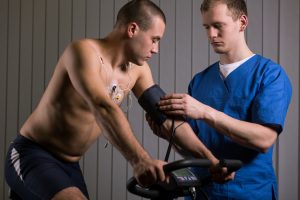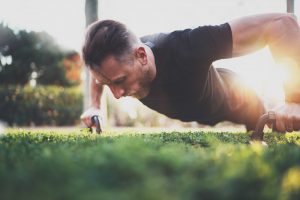A sudden cardiac arrest among athletes is not very common and is rarely caused by a structural heart defect shown by research in The New England Journal of Medicine.
The researchers selected 74 patients between 12 and 45 years old from a Canadian database for cases of sudden cardiac arrest in the period 2009-2014. 16 of these occurred during a competitive sport, the rest during recreational sports.
The incidence of sudden cardiac arrest in the general population of that age is 4.84 cases per 100 thousand persons per years. Among professional athletes, this was 0.76 per 100 thousand athlete years, and more than half of these athletes did not survive.
Hypertrophic cardiomyopathy (a congenital thickening of the heart muscle) seemed to be a major culprit in previous studies, but in only two cases it turned out to be the cause. Arrhythmogenic right ventricular cardiomyopathy (an inherited heart disease) was not found at all as a cause.
Three of these 74 cardiac arrest events that occurred during competitive exercise could have been detected if the athletes had been screened, the researchers write. They estimate that 80 percent of cardiac arrest cases would not have been found with systematic screening, with or without electrocardiography. The authors, therefore, question the value of this screening.

What are your limits?
Depending on your training, your age and your lifestyle, certain limits must be respected. To remain reasonable, the CFLHTA recommends two methods:
- Regular Pulse Measurement – which corresponds to the measurement of cardiac activity. During exercise, a heart rate monitor gives reliable measurements. It is advisable not to exceed an exercise frequency equal to 80% of the formula 220 – age.
Example at 60 years: 220 – 60 = 160 x 80% = 128 beats per minute.
A recent US publication even plans to revise this formula by applying the following formula: 208 – (0.7 x age).
Example: at age 60, 208 – (0.7 x 60) = 166.
- Shortness of breath is a good reflection of our limits. It is recommended to slow down and even stop when you are no longer able to speak during an effort.
In all hypertensive individuals, it is essential to breathe freely during exercise, to avoid short and violent exertion, to respect the three phases of a physical exercise session (warm-up, exercise period, recovery) and not to exceed its limits.
Finally, it is not advisable to go full-throttle in a sporting activity or start a new fitness regime without understanding the health risks. Therefore, talk to your doctor about your intention to resume physical activity and the measures to fight against hypertension; as they will be able to help you choose the most suitable for your condition and adjust if necessary your hypertensive treatment.

Self-measurement to better treat hypertension
- Ask your doctor or pharmacist for advice on how to buy a registered self-test device and how to use it properly.
- Use a blood pressure monitor with a reliable arm cuff.
- Use your device in a sitting position, in the morning before breakfast then in the evening between dinner and bedtime, by performing a series of three consecutive measurements over a few minutes.
- Carry out your self-report for three days, a few days before your medical consultation.
- Show your doctor your self-report; this will help them better treat your hypertension.
Public Blood Pressure Machines
Public blood pressure machines, such as those found in pharmacies, may provide helpful information about your blood pressure, but they may have some limitations. The accuracy of these machines depends on several factors, such as a correct cuff size and proper use of the devices. Ask your doctor for advice on using public blood pressure machines.
Forest Medical Calibration Services
As we specialise in medical equipment testing, we can provide all the help you need to keep your home blood pressure monitor in excellent condition and working at its very best, ensuring that you can continue to receive accurate results and stay well informed about your health. Whether your monitor requires a repair or you simply wish to make sure it is in full working order and giving you accurate readings, we can provide the help you need.
Our service is fast and convenient for you, so you are not left without your vital medical equipment for long periods of time. We aim to complete the calibration and checking of your equipment within 24 hours, and if required, we can repair it free of charge. If you have any concerns about your home testing equipment, send it to us and let us help you keep an eye on your heart health with our medical equipment testing services.

